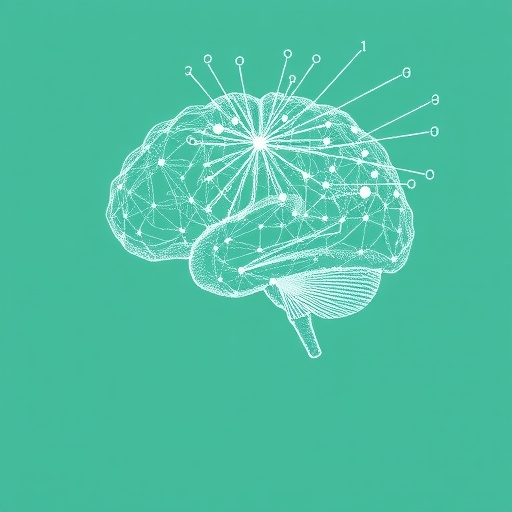In the intricate landscape of adolescent mental health, nonsuicidal self-injury (NSSI) poses a profound clinical puzzle. Despite its alarming prevalence, the neural mechanisms underpinning NSSI, especially in drug-naïve adolescents, remain shrouded in mystery. A groundbreaking study published in BMC Psychiatry in 2025 sheds new light on this pressing issue, unveiling complex disruptions in white matter connectivity within the prefrontal and limbic regions of the adolescent brain. This research not only deepens our understanding of NSSI but also opens promising avenues for future diagnosis and intervention.
NSSI, characterized by deliberate self-harm without suicidal intent, frequently emerges during adolescence, a period marked by rapid brain development and psychological vulnerability. The current study leverages advanced neuroimaging techniques, namely diffusion tensor imaging (DTI), to meticulously map the white matter networks implicated in adolescents exhibiting drug-naïve NSSI. By focusing on individuals who have not received psychiatric medication, the research eliminates confounding variables, allowing for a clearer assessment of the disorder’s neurobiological underpinnings.
Utilizing graph theory, the researchers constructed comprehensive white matter networks encompassing 90 distinct brain regions for each participant. This approach enabled a granular examination of the brain’s structural connectivity, revealing how discrete neural circuits communicate and integrate. Importantly, the cohort included 43 adolescents diagnosed with drug-naïve NSSI and a matched group of 43 healthy controls, providing a robust comparative framework. Additionally, a subset of 20 NSSI participants was reevaluated post-treatment, affording insights into the plasticity of these networks following intervention.
The study’s most striking revelations pertain to augmented structural connectivity within specific right-hemispheric circuits. Adolescents with NSSI demonstrated pronounced connectivity between the right caudate nucleus and three crucial limbic and prefrontal regions: the right olfactory cortex, the right superior frontal gyrus (medial orbital part), and the right amygdala. These areas collectively govern emotion regulation, reward processing, and decision-making, functions critically impaired in NSSI. The heightened connectivity suggests potential maladaptive neural rewiring that may underlie self-injurious behaviors.
Beyond connectivity, graph theory analyses unveiled significant alterations in global and nodal network metrics. Drug-naïve NSSI patients exhibited increased characteristic path length and normalized characteristic path length, signaling less efficient communication across the brain’s white matter network. Concurrently, these individuals showed reduced global efficiency and diminished nodal metrics particularly localized to the right orbital middle frontal gyrus—an area integral to executive function and impulse control. Crucially, these disruptions correlated negatively with anxiety severity and self-injury symptoms, emphasizing their clinical relevance.
After treatment, the subset reassessed revealed further network modifications predominantly within prefrontal regions, the left parahippocampal gyrus, and the left middle occipital gyrus. Such findings suggest that therapeutic interventions might partially normalize dysfunctional connectivity patterns, though the persistence of certain abnormalities highlights the intractable nature of NSSI-related brain changes. This underscores the urgency for targeted, brain-based treatment modalities tailored to these neural circuitries.
The significance of prefrontal and limbic white matter in adolescent psychiatric conditions cannot be overstated. The prefrontal cortex orchestrates higher-order cognitive processes and emotional regulation, while limbic structures like the amygdala underpin affective responses. Disruptions in the intricate dialogue between these regions may predispose vulnerable youths to maladaptive behaviors such as self-injury. By pinpointing distinct connectivity aberrations, this study refines the neurodevelopmental framework of NSSI and bolsters its conceptualization as a disorder of disrupted neural networks.
Methodologically, this research exemplifies the power of combining DTI with graph theory—a sophisticated analytic technique—to unravel the brain’s connective architecture. DTI, by measuring water diffusion along white matter tracts, illuminates the brain’s wiring, while graph metrics quantify properties such as efficiency, integration, and segregation within neural networks. Such an integrative approach marks a leap forward from traditional volumetric or regional analyses, offering nuanced insights into the connectivity disruptions that characterize psychiatric conditions.
From a clinical perspective, these insights carry profound implications. Identifying reliable neuroimaging biomarkers linked to NSSI severity and treatment response could revolutionize diagnostic precision and personalize therapeutic strategies. Moreover, understanding that some white matter network disruptions resist correction post-treatment alerts clinicians to the potential need for early intervention and novel neuromodulatory techniques.
This study also prompts compelling questions regarding the etiology and progression of NSSI. Are these connectivity abnormalities pre-existing vulnerabilities, or do they emerge as maladaptive neuroplastic responses to emotional distress? Longitudinal investigations can elucidate causality and trajectory, advancing preventive mental health measures targeted at at-risk adolescents before the entrenchment of self-harming behaviors.
Furthermore, by spotlighting the altered interaction between right caudate nucleus, prefrontal, and limbic regions, this research dovetails with burgeoning evidence implicating reward and affect circuits in psychiatric disorders. These findings resonate beyond NSSI, potentially informing broader psychopathological models of mood dysregulation, impulsivity, and affective dyscontrol prevalent in adolescent populations.
In sum, the innovative research published in BMC Psychiatry propels our understanding of adolescent NSSI to new frontiers. By illuminating the structural connectivity perturbations in the prefrontal and limbic white matter networks of drug-naïve adolescents, it bridges neurobiological mechanisms with clinical phenomena. Such knowledge paves the way for transformative approaches in diagnosis, intervention, and ultimately, the alleviation of suffering for countless youths grappling with self-injury.
As the scientific community continues to unravel the brain’s complex networks, studies like this reinforce the imperative of integrating neuroimaging with clinical psychiatry. The convergence of cutting-edge imaging modalities and sophisticated analytic frameworks heralds a new era in mental health research—one where the invisible architecture of the mind comes into clearer focus, illuminating pathways toward healing.
Subject of Research: White matter network disruptions in adolescents with drug-naïve nonsuicidal self-injury (NSSI)
Article Title: Intractable prefrontal and limbic white matter network disruption in adolescents with drug-naïve nonsuicidal self-injury
Article References:
Chen, Y., Yang, X., Liao, K. et al. Intractable prefrontal and limbic white matter network disruption in adolescents with drug-naïve nonsuicidal self-injury. BMC Psychiatry 25, 662 (2025). https://doi.org/10.1186/s12888-025-07106-6
Image Credits: AI Generated




